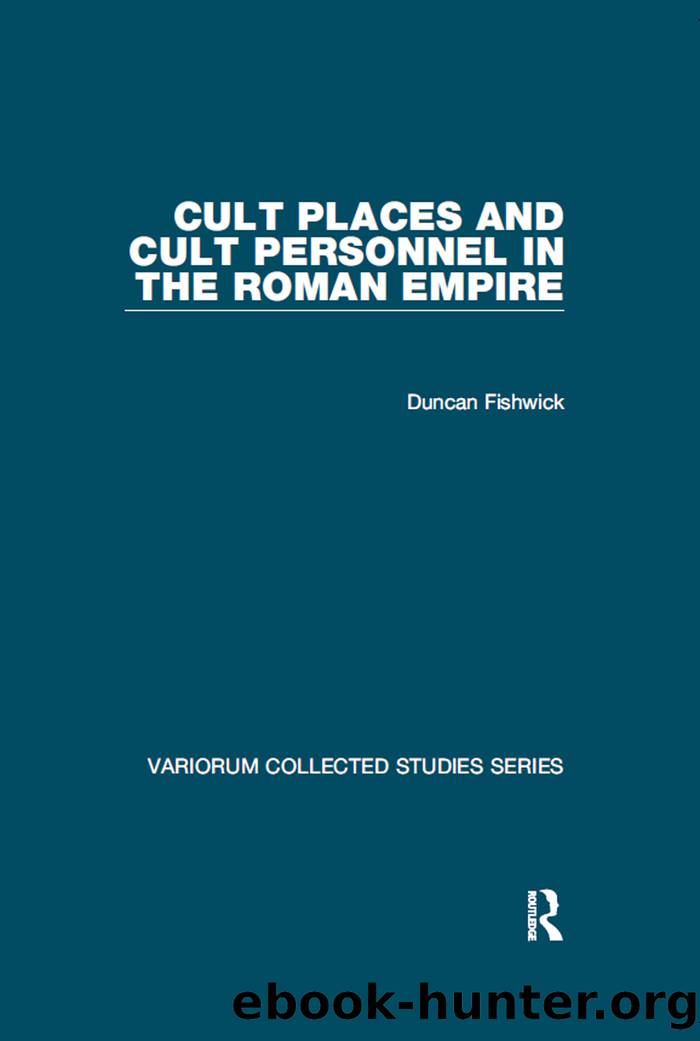Cult Places and Cult Personnel in the Roman Empire by Duncan Fishwick;

Author:Duncan Fishwick;
Language: eng
Format: epub
Publisher: Taylor & Francis (Unlimited)
Published: 2014-08-15T00:00:00+00:00
If anything, therefore, these exceptions to the practice at the federal centre â all in local inscriptions â tell strongly in favour of the possibility that a tribe rather than a cognomen is to be supplied at this point in the Upie inscription. The case looks all the stronger when the expansion Galer[ia, the tribe attributed to Lugdunum, would dovetail nicely with the municipal office of flamen divorum, for which our sole evidence to date happens to come also from Lugdunum (AE, 1966, 252)19.
There is a further point here, overlooked in earlier discussion. The argument for completing the tribe Galeria rather than a name beginning Galer[ is considerably strengthened, if not clinched, by the circumstance that the inscription originates from Valentia. Attention has already been drawn to the inscription of Ti. Claudius Pius, who was enrolled in the tribe Galeria and pursued a local career at Lugdunum (CIL XII, 1750 ; above, p. 414)20. A number of other texts, likewise from Valentia, similarly attest members of the colony at Lugdunum. Thus a tablet with lettering that Hirschfeld dated to the turn of the second century commemorates Q. Iulius Aper, civis Lugdun(ensis), sevir Valentine (CIL XII, 1751) ; while on an altar that served for a taurobolium the same tibicen, Fl(avius) Restitutus, appears as on tituli at Lugdunum (CIL XII, 1745, cf. CIL XIII, 1752â4)). At Montélimar in the same region a monument attests utri[culariii Lu]guduni [consistentes] (CIL XII, 1742). More importantly, at Tegna, a little to the north of Valentia, a taurobolium was performed in A.D. 184 for the salus of Commodus, the divine house, and the Colonia Copia Claudia Augusta by a pontifex perpetuus and other sacerdotes attested at Lugdunum (CIL XII, 1782). This concentration at Valentia and its environs of epigraphical records relating to Lugdunum21 is so striking that Hirschfeld concluded land must have been granted to the inhabitants of the colony of Lugdunum in the neighbouring province of Narbonensis, perhaps the entire territory of Valentia22. He suggested that Claudius, who had been born at Lugdunum, might have been responsible and that this state of affairs continued down to the time of the Severi. Whether this inference is valid or not, the close correspondence of the inscription of M. Bucc[ to so many other epigraphic references to Lugdunum, all at Valentia in the same region of Narbonensis, makes the completion of the tribe Galeria in the highest degree likely. As for the remainder of the line, this would in that case have been occupied by the cognomen, conceivably followed by an ethnic qualification â very possibly Segusiavi (below, p. 418 sq.) That M. Bucc[ will have belonged to the civitas Segusiavorum is, in fact, an assumption fundamental to Maurinâs objection that C. Ulattius was the first of the Segusiavi to reach the federal priesthood in the joint reign of Severus and Caracalla (above, p. 414).
The remaining point in contention is the identification of the final sacerdotium, our only clue to which is the word sacerdos at the end of the preserved text.
Download
This site does not store any files on its server. We only index and link to content provided by other sites. Please contact the content providers to delete copyright contents if any and email us, we'll remove relevant links or contents immediately.
| Africa | Americas |
| Arctic & Antarctica | Asia |
| Australia & Oceania | Europe |
| Middle East | Russia |
| United States | World |
| Ancient Civilizations | Military |
| Historical Study & Educational Resources |
Cecilia; Or, Memoirs of an Heiress — Volume 1 by Fanny Burney(31341)
Cecilia; Or, Memoirs of an Heiress — Volume 3 by Fanny Burney(30938)
Cecilia; Or, Memoirs of an Heiress — Volume 2 by Fanny Burney(30896)
The Secret History by Donna Tartt(16644)
Sapiens: A Brief History of Humankind by Yuval Noah Harari(13067)
Leonardo da Vinci by Walter Isaacson(11912)
The Radium Girls by Kate Moore(10914)
Sapiens by Yuval Noah Harari(4546)
The Wind in My Hair by Masih Alinejad(4427)
How Democracies Die by Steven Levitsky & Daniel Ziblatt(4407)
Homo Deus: A Brief History of Tomorrow by Yuval Noah Harari(4287)
Endurance: Shackleton's Incredible Voyage by Alfred Lansing(3852)
The Silk Roads by Peter Frankopan(3771)
Man's Search for Meaning by Viktor Frankl(3644)
Millionaire: The Philanderer, Gambler, and Duelist Who Invented Modern Finance by Janet Gleeson(3574)
The Rape of Nanking by Iris Chang(3522)
Hitler in Los Angeles by Steven J. Ross(3443)
The Motorcycle Diaries by Ernesto Che Guevara(3340)
Joan of Arc by Mary Gordon(3262)
